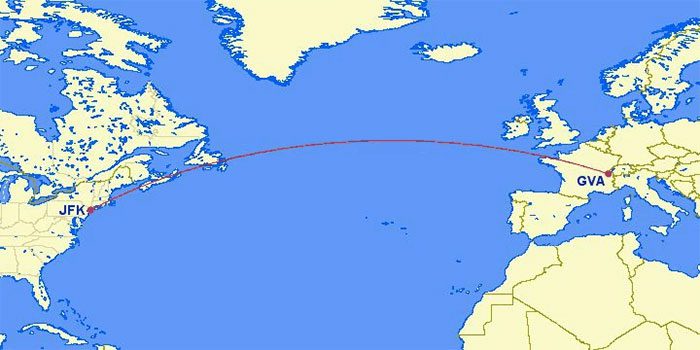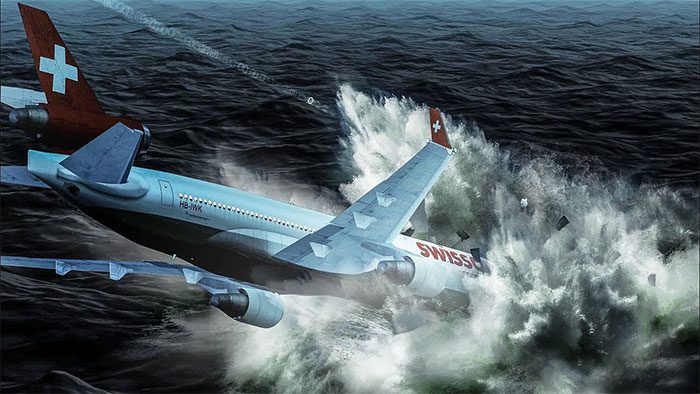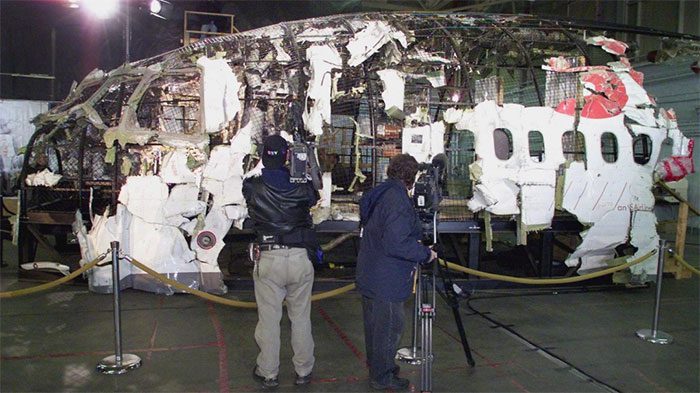At an altitude of 10,000 meters above sea level, the two pilots of the modern MD-11 aircraft were facing a crisis. Smoke filled the cockpit, and communication radar was completely disconnected. The plane, carrying 215 passengers and 14 crew members, plunged straight into the Atlantic Ocean. No one survived.
This was Flight 111 of Swissair – one of the most horrific aviation disasters recorded in history.
Flight 111
On September 2, 1998, Captain Urs Zimmermann (50 years old), a former fighter pilot of the Swiss Air Force, along with First Officer Stefan Löw, was piloting the MD-11 commercial aircraft from New York City to Geneva, Switzerland.

Flight 111 flying over international waters – an area with limited land for emergency landings. (Image: GCmaps)
The flight took off smoothly from New York at 20:18. However, as soon as the aircraft reached an altitude of 10,100 meters, something strange began to occur in the cockpit. Captain Urs Zimmermann noticed a strange smell emanating from the air conditioning system, while the air conditioning in the passenger cabin continued to function normally.
Four minutes later, the strange smell intensified in the cockpit, accompanied by a plume of white smoke. Captain Zimmermann realized that a fire was breaking out on his aircraft.
Zimmermann immediately contacted air traffic control to report the emergency situation. The moment the fire appeared marked the beginning of a countdown to disaster. The crew had only a brief window of time to land before the fire spread throughout the aircraft. Flight 111 was directed to make an emergency landing at Halifax Stanfield International Airport in Canada, over 100 km away.

The plane crashed into the Atlantic after losing radar contact; the last 6 minutes of the flight were completely unrecorded – (Illustrative image (reconstructed in a documentary): TheFlightChannel).
Just four minutes later, the aircraft had covered half the distance to the emergency landing point. The crew requested to extend the flight time to gradually decrease altitude and dump excess fuel.
Notably, during this period, the pilots turned off the power in the aircraft cabin, and the ceiling ventilation fans – an action that inadvertently turned the space above into a suction tube. The fire quickly spread into the cockpit, causing many cockpit systems to fail, including the autopilot and the pilots’ display screens.
The DC-11 was completely out of control. The crew signaled “Mayday” – an emergency distress signal – before losing communication. The aircraft plunged into the Atlantic Ocean at 22:31 at a speed of 555 km/h, breaking apart into millions of pieces in less than a second.
A Tragedy That Changed Aviation
The disaster of Swissair Flight 111 resulted in the loss of 219 lives. Only one victim could be visually identified, while the others had to be identified using DNA, fingerprints, and family dental records. This is considered the largest and most complex DNA identification case in Canadian history.
The Transportation Safety Board of Canada (TSB) launched an investigation into the cause of the accident.
The results indicated that the fire originated from the electrical wiring above the cockpit, rapidly spreading and damaging several aircraft components. The cockpit displays failed, leading the pilots to operate without visual guidance, causing the aircraft to veer off course and crash into the Atlantic Ocean.
The aircraft also lacked a fire detection and suppression system, forcing the crew to rely on smell to recognize the issue when it had already become critical.

The cockpit of the DC-11 aircraft was recovered. (Image: THE CANADIAN PRESS/Andrew Vaughan).
The TSB concluded that the primary cause of the accident was: Inadequate fire safety standards for aircraft materials.
Following the tragedy of Flight 111, numerous recommendations were made to change aircraft material standards, electrical systems, and flight data storage systems. These recommendations led to significant changes in the Federal Aviation Administration (FAA) standards for aircraft manufacturing, altering the safety landscape of the commercial aviation industry worldwide.





















































